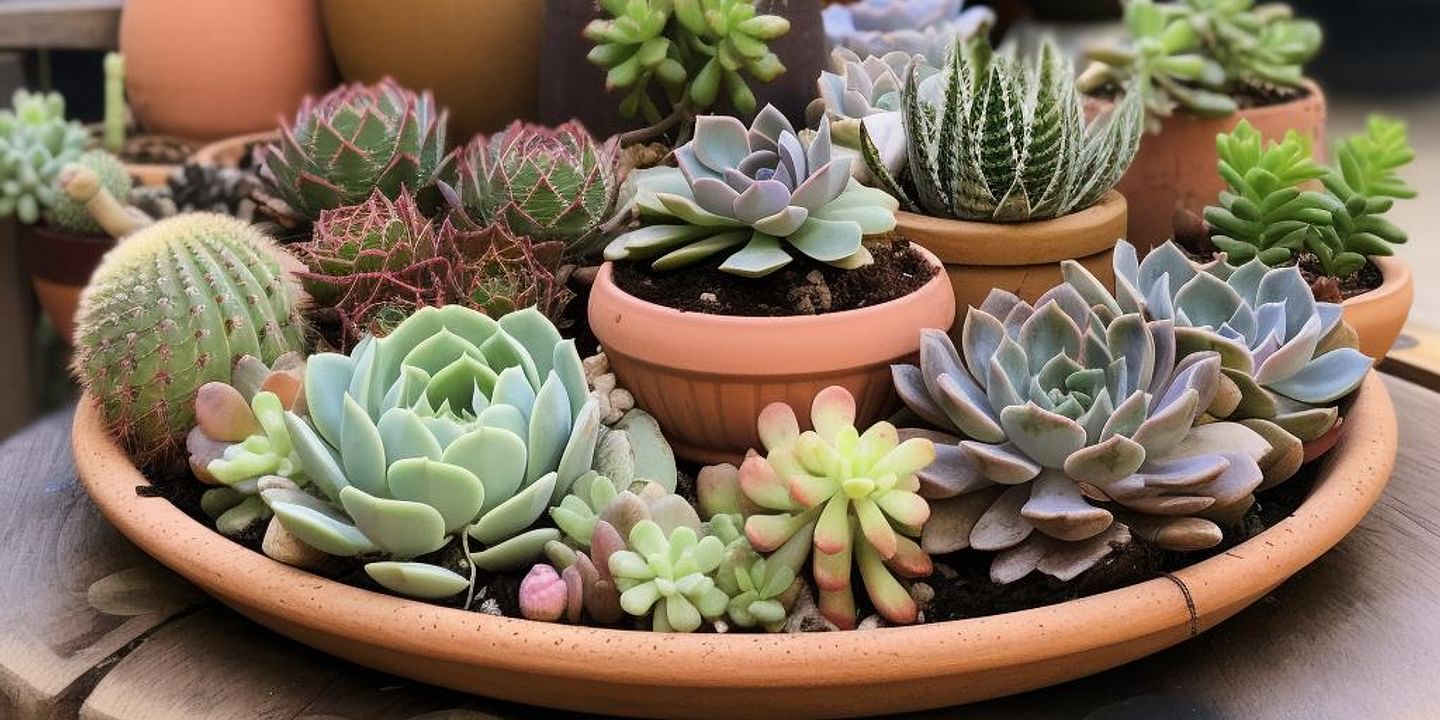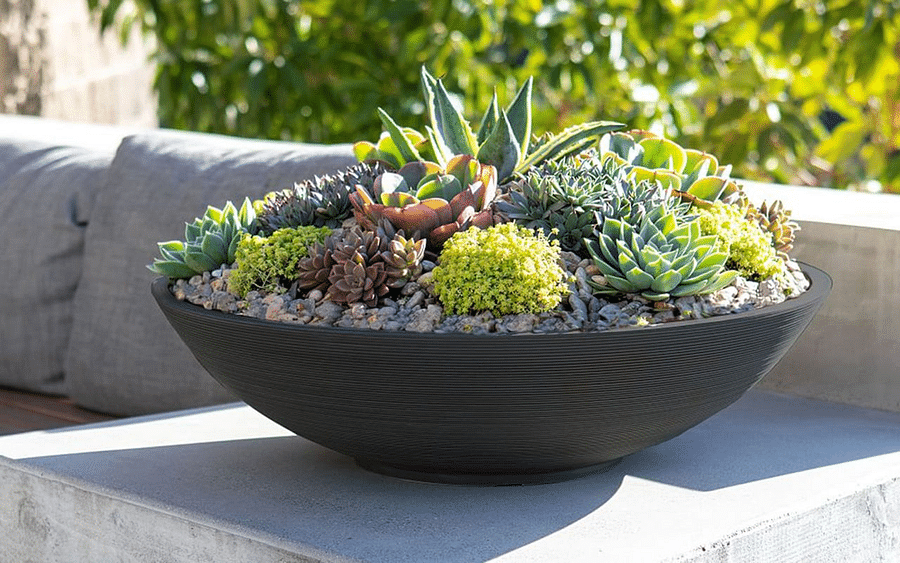

Imagine walking into a room and being greeted by a vibrant collection of succulents, each nestled in a pot that complements its unique beauty and contributes to its overall health and growth.
Yes, the pot - this often overlooked aspect of succulent care holds the secret to your plant's vitality. But how does one navigate the world of best succulent pots, and why is it so crucial? To understand this, let's explore why the right soil and pot are vital for succulent care.
Choosing the right pot
Choosing the right pot for your succulent is akin to selecting a home with the best living conditions. As we thrive in a comfortable and suitable environment, so do our succulent friends.
The ideal pot for succulents ensures proper drainage, supports root growth and maintains an optimal moisture level, which is vital for a thriving succulent. If you're unsure how to choose, our guide on selecting the right soil and pot for your succulent can help.
But with many options available, how deep should a succulent pot be? Do succulents like shallow pots? What about the succulent pot materials and styles? Don't fret!
This comprehensive guide will answer all your questions, from the succulent pot size guide to the plant pot materials and styles suitable for your green companions.
If you're still wondering about the best pot type for indoor succulents, check out our FAQ on the best type for planting indoor succulents.
So, join us as we embark on this exciting journey to discover the perfect home for your succulent. Let's dive into the fascinating world of succulent pots and unveil the secret to healthy, thriving succulents!
And if you're interested in exploring unique succulent varieties, like the Bear Paw Succulent, don't miss our guide on the Bear Paw Succulent.

Choosing the ideal pot for your succulents can seem daunting with the many options available. Should you opt for a ceramic pot, a terracotta one, or a plastic pot? Let's delve into the pros and cons of each material to help you make the best decision. You can also explore our DIY succulent planter ideas for creative and budget-friendly options.
Ceramic pots
Ceramic pots are a popular choice due to their aesthetic appeal. They come in various colors and designs, adding a decorative touch to your succulent display. However, they are heavier and less porous than other materials, which can lead to waterlogging if not properly drained.
Terracotta pots
Terracotta pots, on the other hand, are highly porous, allowing the soil to dry out quickly and preventing root rot. Their earthy tones complement the natural beauty of succulents. But they're fragile and can break easily, so handle them carefully!
Plastic pots
Lastly, plastic pots are lightweight, inexpensive, and durable, making them a practical choice. They retain moisture longer than other materials, which can be beneficial in dry climates. However, they lack the natural look and feel of ceramic or terracotta pots and may not provide the best insulation against temperature fluctuations.
Which is the best succulent pot material?
The answer depends on your specific needs and circumstances. Consider your climate, the specific needs of your succulent species, and your personal style preferences when choosing succulent pots.
You can also refer to our seasonal succulent care tips for more guidance on adjusting care according to climate. Remember, the health and beauty of your succulents depend not only on the care you provide but also on the home you place them in.
Now that we've discussed the pros and cons of various pot materials, let's take a closer look at each one in comparison. This table summarizes the key properties of ceramic, terracotta, and plastic pots, and their suitability for different types of succulents.
| Material | Properties | Pros | Cons | Best for |
|---|---|---|---|---|
| Ceramic | Heavy, less porous, variety of designs | Aesthetic appeal, adds decorative touch | Can lead to waterlogging if not properly drained | Succulents that prefer less frequent watering and indoor display |
| Terracotta | Highly porous, earthy tones | Allows soil to dry out quickly, prevents root rot | Fragile, can break easily | Succulents that require quick drying soil, outdoor display |
| Plastic | Lightweight, durable, retains moisture | Inexpensive, practical choice | Lacks natural look, may not provide best insulation | Succulents in dry climates, beginners |
The table above provides a quick reference for choosing the right pot material for your succulents. Remember, the right pot goes beyond just the material. Next, we'll discuss the importance of choosing the right size for your succulent pot.

Just as a home's foundation is crucial for its stability, the size of your succulent pot is fundamental to its health and growth. Choosing the right pot size for your succulent is much more than a matter of aesthetics; it's a decision that can make or break your plant's survival.
How does pot size affect your succulent, and what size pot should you choose?
After all, isn't that what gardening is all about? If you're new to succulent care, you might find our FAQ on caring for newly bought succulents useful.
Test your knowledge on choosing the right pot size for different succulents based on their type and growth stage.
Learn more about Understanding the Right Pot Size for Your Succulents 🌱 or discover other Succulent Help quizzes.
Stepping beyond the realm of functionality, let's dive into the world of aesthetics. Styling your succulent pots elevates your living space or garden and allows you to express your creativity. The best succulent pots blend seamlessly with your decor while providing a nurturing home for your plants.
Ultimately, the key to styling your succulent pots is having fun with them. Experiment with different succulent pot materials, sizes, and styles until you find what works best for you and your succulents.
After all, isn't the joy of succulent care in watching your plants and style grow together?
For some inspiration on how to style your succulent pots, take a look at this beautifully curated succulent garden.
Experiment with different pot materials, sizes, and styles to create your own unique succulent display.
Best succulent pot
You've chosen the best succulent pot based on your aesthetic preference and plant needs, only to find your succulent wilting after a few weeks. What went wrong? The answer often lies in the drainage system of your pot. Succulents, like their desert-dwelling ancestors, prefer a dry environment. They're not fans of "wet feet," and standing water can lead to root rot, a death sentence for these plants. If you're unsure about the watering needs of your succulents, you can refer to our guide on watering succulents.
Do all succulent pots provide the same level of drainage?"
Not quite. The drainage capability often varies with different succulent pot materials and designs. For instance, terracotta pots are porous, allowing excess water to evaporate naturally. On the other hand, plastic pots retain moisture longer due to their non-porous nature. Therefore, if you're using plastic pots, ensure they have sufficient drainage holes to prevent waterlogging. If you're interested in learning more about pot selection, you can check out this guide on choosing the perfect bonsai pot, which provides useful insights that can be applied to succulent pots.
Do succulents like shallow pots?
Yes, they do. A shallow pot allows water to spread out and evaporate more quickly. But how deep should a succulent pot be? Well, it should be deep enough to accommodate the roots comfortably. Remember, balance is key here. For more tips on creating stunning succulent arrangements, you can visit our guide on succulent arrangements.
So, the next time you're navigating through a succulent pot size guide or a plant pot size chart, remember to consider the drainage aspect. It's not just about what looks good but also what keeps your succulent happy and thriving!
To help you better understand the importance of pot material and size in ensuring proper drainage for your succulents, here's a helpful video tutorial.
Now that you've learned about the importance of proper drainage and how to achieve it with the right pot selection, let's move on to the next section where we will discuss tips on transplanting your succulent to a new pot.
Repotting your succulent is like moving it into a new home. It's an exciting time but it can also be a little nerve-wracking. But don't worry; we're here to guide you through the process, ensuring your succulent transitions smoothly and safely into its new pot.
Remember, succulents are resilient. They might look a little unhappy immediately after repotting, but they'll bounce back quickly with the right care and patience.

Stepping into the world of succulents can be as intriguing as overwhelming. With many questions in your mind, let's dive into the most frequently asked ones about succulent pots.
Choosing the right pot can make a difference to your succulent's health. So, take your time, research, and, most importantly, have fun with it! If you're curious about the different types of succulents that might influence your pot choice, our article on miniature succulents can be a great starting point.

Selecting the ideal succulent pot is an art as much as a science. It's about finding the perfect balance between aesthetics and functionality.
By considering the materials, sizes, and styles discussed in this guide, you can ensure that your succulents thrive and add a touch of beauty to your living spaces.
Remember that succulent pots are not just containers but also a canvas for creativity. You can mix and match styles, experiment with various materials, and let your personality shine through your choices.
With the right pot, you'll enhance the health and growth of your succulents and elevate the overall ambience of your indoor or outdoor garden.
So, go ahead and select the ideal succulent pot that resonates with you and your plants, and watch your succulent garden flourish in style.
We're curious to know which pot material you prefer for your succulents. Your choice can be based on aesthetics, functionality, or both! Share your preference with us.
Post a comment